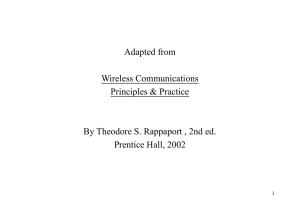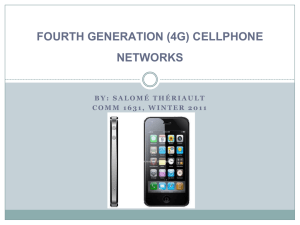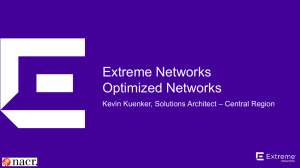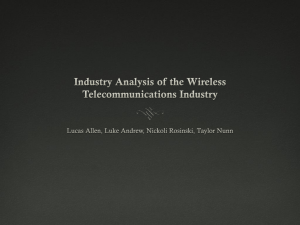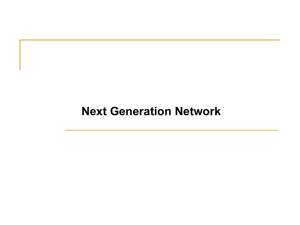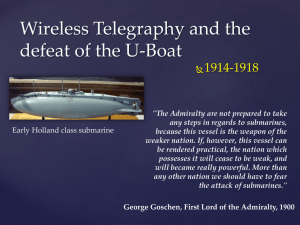Cellular Radio and Personal Communication
advertisement
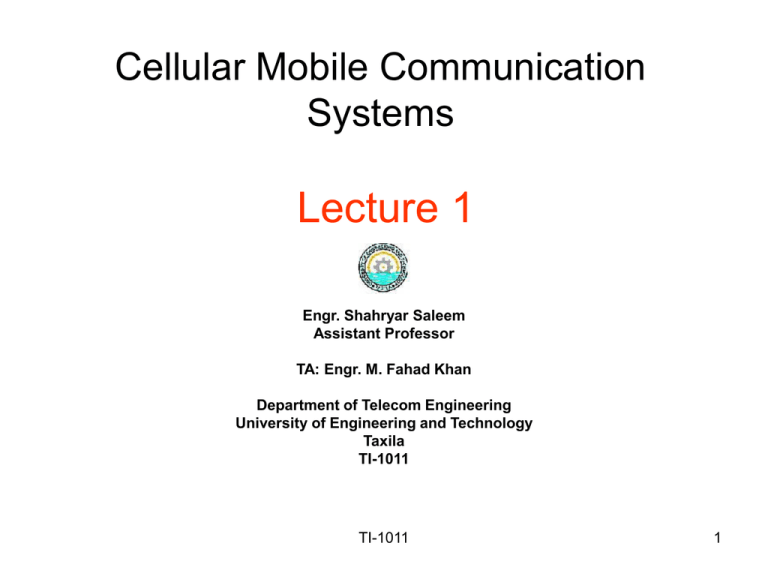
Cellular Mobile Communication Systems Lecture 1 Engr. Shahryar Saleem Assistant Professor TA: Engr. M. Fahad Khan Department of Telecom Engineering University of Engineering and Technology Taxila TI-1011 TI-1011 1 Course Outline • Introduction – Mobile communication systems issues, system structure, safety • Wireless communication fundamentals – Propagation, Modulation and Coding, Frequency reuse. Traffic eng. • Intersystem Operation + Mobility Management – Location tracking and Paging, Handoff • Second Generation Cellular (2G) : – GSM, – IS-95 TI-1011 2 Course Outline • 2.5G Cellular: Wireless Data Services – GPRS (General Packet Radio Service) – EDGE (Enhanced Data GSM Evolution) • 3G Cellular: – Structure, protocols and advance services – UMTS (Universal Mobile Telecom. Services) – Cdma 2000 1x EV-DO (Evolved Data Optimized) • Location Based Systems/Services • Wireless Local Area Networks – 802.11, infrastructure and ad-hoc • Hybrid WLAN and 3G • Wireless MANs TI-1011 3 Course Structure Assignments Quizzes Midterm Final Exam 10% 10% 30% 50% Text: Principles of Wireless Networks: A Unified Approach, by, Kaveh Pahlavan and Prashant Krishnamurthy, Prentice Hall 2002. Online Course Management System: URL: http://web.uettaxila.edu.pk/CMS/coeCMCSms/index.asp Note: • Assignments after the due date will not be accepted. • Plagiarism will not be accepted TI-1011 4 Mobile vs. Wireless • Wireless Communication System: – Any electrical communication system that uses a naturally occurring communication channel, such as air, water, earth. • Mobile wireless communication systems focus – Communicate over the air via radio-waves – Support some form of user mobility • Examine how they are different from wired networks TI-1011 5 Wireless Issues • Wireless link implications – communications channel is the air • poor quality: fading, shadowing, weather, etc. • data rate and coverage vary – regulated by governments • frequency allocated, licensing, etc. – limited bandwidth • low bit rate, frequency planning and reuse, interference – power issues • Power levels regulated (safety issue), conserve mobile terminal battery life – security issues • wireless channel is a broadcast medium! TI-1011 6 Mobility Issues • Mobility Types – User mobility : user can access network while mobile • must handoff calls/connections in progress as user moves • track users as they move so they can receive info/calls – Service mobility: user’s services follow them • Need to have authentication and services follow user • Degree of Mobility – Geographic range • ranges from a house/apartment to worldwide – Speed • ranges from stationary to bullet train • cordless phone vs. cell phone • Mobility portable device TI-1011 7 Device Issues • Mobile Device Issues – Portability • Device and accessories size and weight – Usability • User characteristics (size, dexterity, knowledge, etc.) • Environment characteristics (Temperature, degree of mobility, etc) • Device Characteristics – startup time – data integrity and security – cpu speed and memory size – power supply – user interface (keypad, stylus, voice, etc.) – Functionality (standalone, network dependent) – Connectability (always, partial, never) TI-1011 8 Mobile devices TI-1011 9 Wireless Networks – Wireless Wide Area Networks (WWANs) • Cellular Networks : – GSM, cdmaone (IS-95), UMTS, cdma2000 EVDO • Satellite Networks: – Iridium, Globalstar, GPS, etc. – Wireless Metro Area Networks (WMANs) • IEEE 802.16 WiMAX – Wireless Local Area Networks (WLANs) • IEEE 802.11, a, b, g, etc. (infrastructure, ad hoc, sensor) – Wireless Personal Area Networks (WPANs) • IEEE 802.15 (Bluetooth), IrDa, Zigbee, etc. TI-1011 10 Wireless Networks TI-1011 11 Licensed vs. Unlicensed • Licensed Spectrum – need to buy right to use spectrum allocation in a specific geographic location from the government (e.g., AM/FM radio) – Prevents interference – licensee can control signal quality • Unlicensed spectrum – Anyone can operate in the spectrum (e.g. ISM band for WLANs) but must maintain proper behavior in spectrum (max power level and frequency leakage, etc.) – Can have interference problems TI-1011 12 Frequency Allocations TI-1011 13 Mobile Phone Systems • Mobile phone systems – Support communication to mobile users via wireless radio channel – Variety of systems and standards: • Analog 1G : NMT, AMPS, TACS • Digital 2G: GSM, IS-95b (cdmaone), • 3G: UMTS, cdma 2000 – Scope of services and coverage areas growing • SMS, MMS, laptop data, etc. • Focus now on wireless data and location aware services TI-1011 14 Cellular Network Architecture • Cell : Area covered by 1 radio tower unit (base station) • Cellular Systems: provide wireless coverage to a geographic area with a set of slightly overlapping cells. Use a set of low power radio stations to provide coverage, each cell has different set of frequencies or codes, support handoff of mobile from one cell to another, track mobile for incoming call TI-1011 15 Cellular Network Architecture TI-1011 16 2.5/3G/WLAN Mobile Devices • More Internet-friendly interface – Wide, color screens • More flexible to support new applications – Voice – Video telephony capabilities – Web browsing – Web Games – Location-based services – Streaming applications • Various I/O modes/interfaces – Keypad, – voice recognition, – character recognition, – pen based, etc. TI-1011 17 Functional Units of A Cellular Mobile Network • Base Station (BS) Provides radio channels between mobile units and network Pico-cells : (indoor – 0-.5 Km) support 8-20 channels micro-cells: (outdoor – 0-1 Km), macro-cells: (1-30 Km) • Base Transceiver Station (BTS) - houses radio units • Base Station Controller (BSC) Manages a cluster of BS, channel assignment, handoff, power control, some switching, etc • Mobile Switching Center (MSC) Provides switching functions , coordinates location tracking, call delivery, handoff, interfaces to HLR,VLR, AUC, etc.. TI-1011 18 Functional Units of A Cellular Mobile Network • Home Location Register (HLR) Specialized database server contains subscriber information for billing etc, and part of mobile information to allow incoming calls to be routed to the MSC for a particular MS. • Visitor Location Register (VLR) Similar to HLR which dynamically stores subscriber information when the subscriber is located in the area covered by the VLR. TI-1011 19 Wireless MANs • Wireless Metropolitan Area Network (WMAN) – Wireless alternative to DSL/cable modem services for last mile broadband access. – Point to Multipoint (PMP) protocol – Scope expanded to include mobility and higher data rates – IEEE 802.16 standard – Worldwide Interoperability for Wireless Microwave Access (WiMAX) • Focus on both licensed and unlicensed spectrum deployment • Advantages: cost, flexibility, mobility TI-1011 20 WiMAX Architecture TI-1011 21 WiMAX service Architecture •NLOS has lower data rate up to 32 Mbps •LOS, where a fixed antenna points straight at the WiMax tower from a rooftop or pole. can provide higher data rates ~ 75Mbps • Point to Point Focused LOS antennas – high data rates with longer distances 30-40 miles suitable for wireless backhaul ~100 Mbps •MAC layer protocol has QoS service specifications built in TI-1011 22 WiMAX service Architecture TI-1011 23 WiMAX Applications • According to WiMax Forum it supports 5 classes of applications: • 1. Multi-player Interactive Gaming. • 2. VOIP and Video Conference • 3. Streaming Media • 4. Web Browsing and Instant Messaging • 5. Media Content Downloads • Basically Triple Play TI-1011 24 Wireless LANs • Wireless Local Area Networks – Support communication to mobile data users via wireless channel – Types of WLAN 1. Infrastructure based (most popular) Connect users to a wired infrastructure network Wireless access network like cellular phone system IEEE 802.11, a, b, g , etc. 2. Ad-Hoc based networks – Provide peer to peer communication – mobiles communicate between each other directly – Rapid Deployment (conference room) – Bluetooth, IEEE 802.11, a, b, g Proprietary 3. Point – to – Point (cable replacement!) TI-1011 25 Wireless LAN Components TI-1011 26 IEEE 802.11Terminology • Access Point (AP) – Provides access to distribution services via the wireless medium • Basic Service Area (BSA) – The coverage area of one access point • Basic Service Set (BSS) – A set of mobile stations controlled by one access point • Distribution system – The fixed (wired) infrastructure used to connect a set of BSS to create an extended service set (ESS) • Portal(s) – The logical point(s) at which non-802.11 packets enter an ESS TI-1011 27 WLAN Topologies TI-1011 28 Major Players • Wireless LAN market – Lucent (Orinoco) – Alcatel – Cisco – 3Com – Alvarion • Indoor and Outdoor systems – Outdoor range - up to 25 Km claimed – Wireless ISPs in many cities • Expand market and scope of services TI-1011 29 Ad-hoc Networks • In Latin, ad hoc literally means "for this purpose only.” • Ad-hoc network: – A LAN or other small network, especially one with wireless connections, in which some of the network devices are part of the network only for the duration of a communication session or, in the case of mobile or portable devices, while in some close proximity to the rest of the network. TI-1011 30 Ad-hoc Networks Lap-tops in a conference room TI-1011 31 Why Ad-hoc Networking • Useful when infrastructure not available, impractical, or expensive • Technically: – Mobile devices internetworking; – Wireless hardware becomes a commodity ----- increasing performance and inexpensive – Market demand: – Mobile conferencing, etc – Home networking – Emergency services – Military applications – Taxi-cab network TI-1011 32 Sensor Networks • Specialized wireless networks to gather data from a specific system, usually no mobility of sensor nodes – APPLICATIONS: Military, Environmental, Health, Home, Space Exploration, Chemical Processing – SENSOR TYPES: Seismic, Low Sampling Rate Magnetic, Thermal, Visual, Infrared, Acoustic, Radar… – SENSOR TASKS: Temperature, Humidity, Vehicular Movement, Lightning Condition, Pressure, Soil Makeup, Noise Levels, Presence or Absence of Certain Types of Objects, Mechanical Stress Levels on Attached Objects, Current Characteristics (Speed, Direction, Size) of an Object …. TI-1011 33 Example Sensor Network TI-1011 34 Wireless Personal Area Networks • Origins in the BodyLAN project initiated by BBN in the early 1990s • Networking “personal” devices – sensors, cameras, handheld computers, audio devices, etc. with a range of around 5 feet around a soldier • Today: Networking digital cameras to cell phones to PDAs to laptops to printers to etc.., • Most popular application – handsfree headset to cellphone • IEEE 802.15 standard (Bluetooth) – Use band available globally for unlicensed users – Low powered – medium data rate ~100s kbps TI-1011 35 Applications of WPAN TI-1011 36 QUESTIONS ? TI-1011 37

